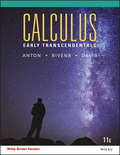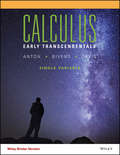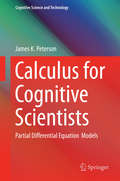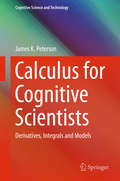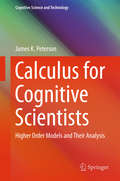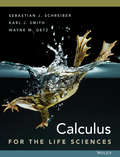- Table View
- List View
Calculus All-in-One For Dummies (+ Chapter Quizzes Online)
by Mark RyanMake calculus more manageable with simplified instruction and tons of practice Calculus All-in-One For Dummies pairs no-nonsense explanations of calculus content with practical examples and practice problems, so you can untangle the difficult concepts and improve your score in any calculus class. Plus, this book comes with access to chapter quizzes online. Dummies makes differentiation, integration, and everything in between more manageable, so you can crush calculus with confidence. Review the foundational basics, then dive into calc lessons that track your class. This book takes you through a full year of high-school calculus or a first semester of college calculus, only explained more clearly. Work through easy-to-understand lessons on everything in a typical calc class Get the score you want and need on standardized tests like AP Calculus Access online chapter quizzes for additional practice Untangle tricky problems and discover clever ways to solve themWith clear definitions, concise explanations, and plenty of helpful information on everything from limits and vectors to integration and curve-sketching, Calculus All-in-One For Dummies is the must-have resource for students who want to review for exams or just need extra help understanding the concepts from class.
Calculus All-in-One For Dummies (+ Chapter Quizzes Online)
by Mark RyanMake calculus more manageable with simplified instruction and tons of practice Calculus All-in-One For Dummies pairs no-nonsense explanations of calculus content with practical examples and practice problems, so you can untangle the difficult concepts and improve your score in any calculus class. Plus, this book comes with access to chapter quizzes online. Dummies makes differentiation, integration, and everything in between more manageable, so you can crush calculus with confidence. Review the foundational basics, then dive into calc lessons that track your class. This book takes you through a full year of high-school calculus or a first semester of college calculus, only explained more clearly. Work through easy-to-understand lessons on everything in a typical calc class Get the score you want and need on standardized tests like AP Calculus Access online chapter quizzes for additional practice Untangle tricky problems and discover clever ways to solve themWith clear definitions, concise explanations, and plenty of helpful information on everything from limits and vectors to integration and curve-sketching, Calculus All-in-One For Dummies is the must-have resource for students who want to review for exams or just need extra help understanding the concepts from class.
Calculus and Analysis in Euclidean Space (Undergraduate Texts in Mathematics)
by Jerry ShurmanThe graceful role of analysis in underpinning calculus is often lost to their separation in the curriculum. This book entwines the two subjects, providing a conceptual approach to multivariable calculus closely supported by the structure and reasoning of analysis. The setting is Euclidean space, with the material on differentiation culminating in the inverse and implicit function theorems, and the material on integration culminating in the general fundamental theorem of integral calculus. More in-depth than most calculus books but less technical than a typical analysis introduction, Calculus and Analysis in Euclidean Space offers a rich blend of content to students outside the traditional mathematics major, while also providing transitional preparation for those who will continue on in the subject. The writing in this book aims to convey the intent of ideas early in discussion. The narrative proceeds through figures, formulas, and text, guiding the reader to do mathematics resourcefully by marshaling the skills of geometric intuition (the visual cortex being quickly instinctive) algebraic manipulation (symbol-patterns being precise and robust) incisive use of natural language (slogans that encapsulate central ideas enabling a large-scale grasp of the subject). Thinking in these ways renders mathematics coherent, inevitable, and fluid. The prerequisite is single-variable calculus, including familiarity with the foundational theorems and some experience with proofs.
Calculus and Linear Algebra in Recipes: Terms, phrases and numerous examples in short learning units
by Christian KarpfingerThis book provides a clear and easy-to-understand introduction to higher mathematics with numerous examples. The author shows how to solve typical problems in a recipe-like manner and divides the material into short, easily digestible learning units.Have you ever cooked a 3-course meal based on a recipe? That generally works quite well, even if you are not a great cook. What does this have to do with mathematics? Well, you can solve a lot of math problems recipe-wise: Need to solve a Riccati's differential equation or the singular value decomposition of a matrix? Look it up in this book, you'll find a recipe for it here. Recipes are available for problems from the· Calculus in one and more variables,· linear algebra,· Vector Analysis,· Theory on differential equations, ordinary and partial,· Theory of integral transformations,· Function theory.Other features of this book include:· The division of Higher Mathematics into approximately 100 chapters of roughly equal length. Each chapter covers approximately the material of a 90-minute lecture.· Many tasks, the solutions to which can be found in the accompanying workbook.· Many problems in higher mathematics can be solved with computers. We always indicate how it works with MATLAB®.For the present 3rd edition, the book has been completely revised and supplemented by a section on the solution of boundary value problems for ordinary differential equations, by the topic of residue estimates for Taylor expansions and by the characteristic method for partial differential equations of the 1st order, as well as by several additional problems.
Calculus and Mechanics on Two-Point Homogenous Riemannian Spaces (Lecture Notes in Physics #707)
by Alexey V. ShchepetilovThis is an introduction to classical and quantum mechanics on two-point homogenous Riemannian spaces, empahsizing spaces with constant curvature. Chapters 1-4 provide basic notations for studying two-body dynamics. Chapter 5 deals with the problem of finding explicitly invariant expressions for the two-body quantum Hamiltonian. Chapter 6 addresses one-body problems in a central potential. Chapter 7 investigates the classical counterpart of the quantum system introduced in Chapter 5. Chapter 8 discusses applications in the quantum realm.
Calculus Early Transcendentals
by Howard Anton Irl C. Bivens Stephen DavisCalculus: Early Transcendentals, 11th Edition strives to increase student comprehension and conceptual understanding through a balance between rigor and clarity of explanations; sound mathematics; and excellent exercises, applications, and examples. Anton pedagogically approaches Calculus through the Rule of Four, presenting concepts from the verbal, algebraic, visual, and numerical points of view.
Calculus: Early Transcendentals
by Jon Rogawski Colin AdamsThe most successful calculus book of its generation, Jon Rogawski's Calculus offers an ideal balance of formal precision and dedicated conceptual focus, helping students build strong computational skills while continually reinforcing the relevance of calculus to their future studies and their lives.Guided by new author Colin Adams, the new edition stays true to the late Jon Rogawski's refreshing and highly effective approach, while drawing on extensive instructor and student feedback, and Adams' three decades as a calculus teacher and author of math books for general audiences.The new edition is also a fully integrated text/media package, with its own dedicated version of LaunchPad, W. H. Freeman's breakthrough online course space.
Calculus Early Transcendentals Single Variable
by Howard Anton Irl C. Bivens Stephen DavisCalculus: Early Transcendentals, 11th Edition strives to increase student comprehension and conceptual understanding through a balance between rigor and clarity of explanations; sound mathematics; and excellent exercises, applications, and examples. Anton pedagogically approaches Calculus through the Rule of Four, presenting concepts from the verbal, algebraic, visual, and numerical points of view.
Calculus Essentials For Dummies
by Mark RyanCalculus Essentials For Dummies (9781119591207) was previously published as Calculus Essentials For Dummies (9780470618356). While this version features a new Dummies cover and design, the content is the same as the prior release and should not be considered a new or updated product. Many colleges and universities require students to take at least one math course, and Calculus I is often the chosen option. Calculus Essentials For Dummies provides explanations of key concepts for students who may have taken calculus in high school and want to review the most important concepts as they gear up for a faster-paced college course. Free of review and ramp-up material, Calculus Essentials For Dummies sticks to the point with content focused on key topics only. It provides discrete explanations of critical concepts taught in a typical two-semester high school calculus class or a college level Calculus I course, from limits and differentiation to integration and infinite series. This guide is also a perfect reference for parents who need to review critical calculus concepts as they help high school students with homework assignments, as well as for adult learners headed back into the classroom who just need a refresher of the core concepts. The Essentials For Dummies Series Dummies is proud to present our new series, The Essentials For Dummies. Now students who are prepping for exams, preparing to study new material, or who just need a refresher can have a concise, easy-to-understand review guide that covers an entire course by concentrating solely on the most important concepts. From algebra and chemistry to grammar and Spanish, our expert authors focus on the skills students most need to succeed in a subject.
Calculus Essentials For Dummies
by Mark RyanCalculus Essentials For Dummies (9781119591207) was previously published as Calculus Essentials For Dummies (9780470618356). While this version features a new Dummies cover and design, the content is the same as the prior release and should not be considered a new or updated product. Many colleges and universities require students to take at least one math course, and Calculus I is often the chosen option. Calculus Essentials For Dummies provides explanations of key concepts for students who may have taken calculus in high school and want to review the most important concepts as they gear up for a faster-paced college course. Free of review and ramp-up material, Calculus Essentials For Dummies sticks to the point with content focused on key topics only. It provides discrete explanations of critical concepts taught in a typical two-semester high school calculus class or a college level Calculus I course, from limits and differentiation to integration and infinite series. This guide is also a perfect reference for parents who need to review critical calculus concepts as they help high school students with homework assignments, as well as for adult learners headed back into the classroom who just need a refresher of the core concepts. The Essentials For Dummies Series Dummies is proud to present our new series, The Essentials For Dummies. Now students who are prepping for exams, preparing to study new material, or who just need a refresher can have a concise, easy-to-understand review guide that covers an entire course by concentrating solely on the most important concepts. From algebra and chemistry to grammar and Spanish, our expert authors focus on the skills students most need to succeed in a subject.
Calculus for Cognitive Scientists: Partial Differential Equation Models (Cognitive Science and Technology #0)
by James PetersonThis book shows cognitive scientists in training how mathematics, computer science and science can be usefully and seamlessly intertwined. It is a follow-up to the first two volumes on mathematics for cognitive scientists, and includes the mathematics and computational tools needed to understand how to compute the terms in the Fourier series expansions that solve the cable equation. The latter is derived from first principles by going back to cellular biology and the relevant biophysics. A detailed discussion of ion movement through cellular membranes, and an explanation of how the equations that govern such ion movement leading to the standard transient cable equation are included. There are also solutions for the cable model using separation of variables, as well an explanation of why Fourier series converge and a description of the implementation of MatLab tools to compute the solutions. Finally, the standard Hodgkin - Huxley model is developed for an excitable neuron and is solved using MatLab.
Calculus for Cognitive Scientists: Derivatives, Integrals and Models (Cognitive Science and Technology #0)
by James K. PetersonThis book provides a self-study program on how mathematics, computer science and science can be usefully and seamlessly intertwined. Learning to use ideas from mathematics and computation is essential for understanding approaches to cognitive and biological science. As such the book covers calculus on one variable and two variables and works through a number of interesting first-order ODE models. It clearly uses MatLab in computational exercises where the models cannot be solved by hand, and also helps readers to understand that approximations cause errors – a fact that must always be kept in mind.
Calculus for Cognitive Scientists: Higher Order Models and Their Analysis (Cognitive Science and Technology #0)
by James K. PetersonThis book offers a self-study program on how mathematics, computer science and science can be profitably and seamlessly intertwined. This book focuses on two variable ODE models, both linear and nonlinear, and highlights theoretical and computational tools using MATLAB to explain their solutions. It also shows how to solve cable models using separation of variables and the Fourier Series.
Calculus for Computer Graphics
by John VinceStudents studying different branches of computer graphics have to be familiar with geometry, matrices, vectors, rotation transforms, quaternions, curves and surfaces and as computer graphics software becomes increasingly sophisticated, calculus is also being used to resolve its associated problems. In this 2nd edition, the author extends the scope of the original book to include applications of calculus in the areas of arc-length parameterisation of curves, geometric continuity, tangent and normal vectors, and curvature. The author draws upon his experience in teaching mathematics to undergraduates to make calculus appear no more challenging than any other branch of mathematics. He introduces the subject by examining how functions depend upon their independent variables, and then derives the appropriate mathematical underpinning and definitions. This gives rise to a function’s derivative and its antiderivative, or integral. Using the idea of limits, the reader is introduced to derivatives and integrals of many common functions. Other chapters address higher-order derivatives, partial derivatives, Jacobians, vector-based functions, single, double and triple integrals, with numerous worked examples, and over a hundred and seventy colour illustrations. This book complements the author’s other books on mathematics for computer graphics, and assumes that the reader is familiar with everyday algebra, trigonometry, vectors and determinants. After studying this book, the reader should understand calculus and its application within the world of computer graphics, games and animation.
Calculus for Computer Graphics
by John VinceStudents studying computer animation and computer games have to be familiar with geometry, matrices, vectors, rotation transforms, quaternions, curves and surfaces, and as computer graphics software becomes increasingly sophisticated, calculus is also being used to resolve its associated problems.The author draws upon his experience in teaching mathematics to undergraduates to make calculus appear no more challenging than any other branch of mathematics. He introduces the subject by examining how functions depend upon their independent variables, and then derives the appropriate mathematical underpinning and definitions. This gives rise to a function’s derivative and its antiderivative, or integral. Using the idea of limits, the reader is introduced to derivatives and integrals of many common functions. Other chapters address higher-order derivatives, partial derivatives, Jacobians, vector-based functions, single, double and triple integrals, with numerous worked examples, and over a hundred illustrations. Calculus for Computer Graphics complements the author’s other books on mathematics for computer graphics, and assumes that the reader is familiar with everyday algebra, trigonometry, vectors and determinants. After studying this book, the reader should understand calculus and its application within the world of computer games and animation.
Calculus for Computer Graphics
by John VinceStudents studying different branches of computer graphics need to be familiar with geometry, matrices, vectors, rotation transforms, quaternions, curves and surfaces. And as computer graphics software becomes increasingly sophisticated, calculus is also being used to resolve its associated problems.In this 3rd edition, the author extends the scope of the original book to include vector differential operators and differential equations and draws upon his experience in teaching mathematics to undergraduates to make calculus appear no more challenging than any other branch of mathematics. He introduces the subject by examining how functions depend upon their independent variables, and then derives the appropriate mathematical underpinning and definitions. This gives rise to a function’s derivative and its antiderivative, or integral. Using the idea of limits, the reader is introduced to derivatives and integrals of many common functions. Other chapters address higher-order derivatives, partial derivatives, Jacobians, vector-based functions, single, double and triple integrals, with numerous worked examples and almost two hundred colour illustrations. This book complements the author’s other books on mathematics for computer graphics and assumes that the reader is familiar with everyday algebra, trigonometry, vectors and determinants. After studying this book, the reader should understand calculus and its application within the world of computer graphics, games and animation.
Calculus For Dummies (For Dummies)
by Mark RyanCalculus For Dummies, 2nd Edition (9781119293491) was previously published as Calculus For Dummies, 2nd Edition (9781118791295). While this version features a new Dummies cover and design, the content is the same as the prior release and should not be considered a new or updated product. Slay the calculus monster with this user-friendly guide Calculus For Dummies, 2nd Edition makes calculus manageable—even if you're one of the many students who sweat at the thought of it. By breaking down differentiation and integration into digestible concepts, this guide helps you build a stronger foundation with a solid understanding of the big ideas at work. This user-friendly math book leads you step-by-step through each concept, operation, and solution, explaining the "how" and "why" in plain English instead of math-speak. Through relevant instruction and practical examples, you'll soon learn that real-life calculus isn't nearly the monster it's made out to be. Calculus is a required course for many college majors, and for students without a strong math foundation, it can be a real barrier to graduation. Breaking that barrier down means recognizing calculus for what it is—simply a tool for studying the ways in which variables interact. It's the logical extension of the algebra, geometry, and trigonometry you've already taken, and Calculus For Dummies, 2nd Edition proves that if you can master those classes, you can tackle calculus and win. Includes foundations in algebra, trigonometry, and pre-calculus concepts Explores sequences, series, and graphing common functions Instructs you how to approximate area with integration Features things to remember, things to forget, and things you can't get away with Stop fearing calculus, and learn to embrace the challenge. With this comprehensive study guide, you'll gain the skills and confidence that make all the difference. Calculus For Dummies, 2nd Edition provides a roadmap for success, and the backup you need to get there.
Calculus For Dummies
by Mark RyanSlay the calculus monster with this user-friendly guide Calculus For Dummies, 2nd Edition makes calculus manageable—even if you're one of the many students who sweat at the thought of it. By breaking down differentiation and integration into digestible concepts, this guide helps you build a stronger foundation with a solid understanding of the big ideas at work. This user-friendly math book leads you step-by-step through each concept, operation, and solution, explaining the "how" and "why" in plain English instead of math-speak. Through relevant instruction and practical examples, you'll soon learn that real-life calculus isn't nearly the monster it's made out to be. Calculus is a required course for many college majors, and for students without a strong math foundation, it can be a real barrier to graduation. Breaking that barrier down means recognizing calculus for what it is—simply a tool for studying the ways in which variables interact. It's the logical extension of the algebra, geometry, and trigonometry you've already taken, and Calculus For Dummies, 2nd Edition proves that if you can master those classes, you can tackle calculus and win. Includes foundations in algebra, trigonometry, and pre-calculus concepts Explores sequences, series, and graphing common functions Instructs you how to approximate area with integration Features things to remember, things to forget, and things you can't get away with Stop fearing calculus, and learn to embrace the challenge. With this comprehensive study guide, you'll gain the skills and confidence that make all the difference. Calculus For Dummies, 2nd Edition provides a roadmap for success, and the backup you need to get there.
A Calculus for Factorial Arrangements (Lecture Notes in Statistics #59)
by Sudhir Gupta Rahul MukerjeeFactorial designs were introduced and popularized by Fisher (1935). Among the early authors, Yates (1937) considered both symmetric and asymmetric factorial designs. Bose and Kishen (1940) and Bose (1947) developed a mathematical theory for symmetric priIi't&-powered factorials while Nair and Roo (1941, 1942, 1948) introduced and explored balanced confounded designs for the asymmetric case. Since then, over the last four decades, there has been a rapid growth of research in factorial designs and a considerable interest is still continuing. Kurkjian and Zelen (1962, 1963) introduced a tensor calculus for factorial arrangements which, as pointed out by Federer (1980), represents a powerful statistical analytic tool in the context of factorial designs. Kurkjian and Zelen (1963) gave the analysis of block designs using the calculus and Zelen and Federer (1964) applied it to the analysis of designs with two-way elimination of heterogeneity. Zelen and Federer (1965) used the calculus for the analysis of designs having several classifications with unequal replications, no empty cells and with all the interactions present. Federer and Zelen (1966) considered applications of the calculus for factorial experiments when the treatments are not all equally replicated, and Paik and Federer (1974) provided extensions to when some of the treatment combinations are not included in the experiment. The calculus, which involves the use of Kronecker products of matrices, is extremely helpful in deriving characterizations, in a compact form, for various important features like balance and orthogonality in a general multifactor setting.
Calculus for The Life Sciences
by Sebastian J. Schreiber Karl Smith Wayne GetzAuthored by two distinguished researchers/teachers and an experiences, successful textbook author, Calculus for Life Sciences is a valuable resource for Life Science courses. As life-science departments increase the math requirements for their majors, there is a need for greater mathematic knowledge among students. This text balances rigorous mathematical training with extensive modeling of biological problems. The biological examples from health science, ecology, microbiology, genetics, and other domains, many based on cited data, are key features of this text.
Calculus for Scientists and Engineers (Industrial and Applied Mathematics)
by Martin Brokate Pammy Manchanda Abul Hasan SiddiqiThis book presents the basic concepts of calculus and its relevance to real-world problems, covering the standard topics in their conventional order. By focusing on applications, it allows readers to view mathematics in a practical and relevant setting. Organized into 12 chapters, this book includes numerous interesting, relevant and up-to date applications that are drawn from the fields of business, economics, social and behavioural sciences, life sciences, physical sciences, and other fields of general interest. It also features MATLAB, which is used to solve a number of problems. The book is ideal as a first course in calculus for mathematics and engineering students. It is also useful for students of other sciences who are interested in learning calculus.
The Calculus Gallery: Masterpieces from Newton to Lebesgue
by William DunhamMore than three centuries after its creation, calculus remains a dazzling intellectual achievement and the gateway into higher mathematics. This book charts its growth and development by sampling from the work of some of its foremost practitioners, beginning with Isaac Newton and Gottfried Wilhelm Leibniz in the late seventeenth century and continuing to Henri Lebesgue at the dawn of the twentieth--mathematicians whose achievements are comparable to those of Bach in music or Shakespeare in literature. William Dunham lucidly presents the definitions, theorems, and proofs. "Students of literature read Shakespeare; students of music listen to Bach," he writes. But this tradition of studying the major works of the "masters" is, if not wholly absent, certainly uncommon in mathematics. This book seeks to redress that situation. Like a great museum, The Calculus Gallery is filled with masterpieces, among which are Bernoulli's early attack upon the harmonic series (1689), Euler's brilliant approximation of pi (1779), Cauchy's classic proof of the fundamental theorem of calculus (1823), Weierstrass's mind-boggling counterexample (1872), and Baire's original "category theorem" (1899). Collectively, these selections document the evolution of calculus from a powerful but logically chaotic subject into one whose foundations are thorough, rigorous, and unflinching--a story of genius triumphing over some of the toughest, most subtle problems imaginable. Anyone who has studied and enjoyed calculus will discover in these pages the sheer excitement each mathematician must have felt when pushing into the unknown. In touring The Calculus Gallery, we can see how it all came to be.
The Calculus Gallery: Masterpieces from Newton to Lebesgue
by William DunhamMore than three centuries after its creation, calculus remains a dazzling intellectual achievement and the gateway into higher mathematics. This book charts its growth and development by sampling from the work of some of its foremost practitioners, beginning with Isaac Newton and Gottfried Wilhelm Leibniz in the late seventeenth century and continuing to Henri Lebesgue at the dawn of the twentieth--mathematicians whose achievements are comparable to those of Bach in music or Shakespeare in literature. William Dunham lucidly presents the definitions, theorems, and proofs. "Students of literature read Shakespeare; students of music listen to Bach," he writes. But this tradition of studying the major works of the "masters" is, if not wholly absent, certainly uncommon in mathematics. This book seeks to redress that situation. Like a great museum, The Calculus Gallery is filled with masterpieces, among which are Bernoulli's early attack upon the harmonic series (1689), Euler's brilliant approximation of pi (1779), Cauchy's classic proof of the fundamental theorem of calculus (1823), Weierstrass's mind-boggling counterexample (1872), and Baire's original "category theorem" (1899). Collectively, these selections document the evolution of calculus from a powerful but logically chaotic subject into one whose foundations are thorough, rigorous, and unflinching--a story of genius triumphing over some of the toughest, most subtle problems imaginable. Anyone who has studied and enjoyed calculus will discover in these pages the sheer excitement each mathematician must have felt when pushing into the unknown. In touring The Calculus Gallery, we can see how it all came to be.
The Calculus Gallery: Masterpieces from Newton to Lebesgue (Princeton Science Library #60)
by William DunhamMore than three centuries after its creation, calculus remains a dazzling intellectual achievement and the gateway to higher mathematics. This book charts its growth and development by sampling from the work of some of its foremost practitioners, beginning with Isaac Newton and Gottfried Wilhelm Leibniz in the late seventeenth century and continuing to Henri Lebesgue at the dawn of the twentieth. Now with a new preface by the author, this book documents the evolution of calculus from a powerful but logically chaotic subject into one whose foundations are thorough, rigorous, and unflinching—a story of genius triumphing over some of the toughest, subtlest problems imaginable. In touring The Calculus Gallery, we can see how it all came to be.
The Calculus Gallery: Masterpieces from Newton to Lebesgue (Princeton Science Library #60)
by William DunhamMore than three centuries after its creation, calculus remains a dazzling intellectual achievement and the gateway to higher mathematics. This book charts its growth and development by sampling from the work of some of its foremost practitioners, beginning with Isaac Newton and Gottfried Wilhelm Leibniz in the late seventeenth century and continuing to Henri Lebesgue at the dawn of the twentieth. Now with a new preface by the author, this book documents the evolution of calculus from a powerful but logically chaotic subject into one whose foundations are thorough, rigorous, and unflinching—a story of genius triumphing over some of the toughest, subtlest problems imaginable. In touring The Calculus Gallery, we can see how it all came to be.




